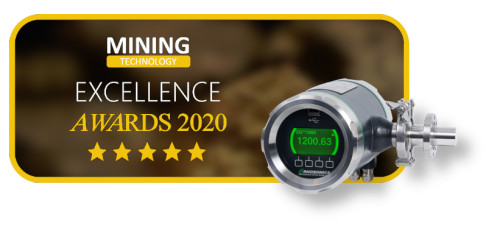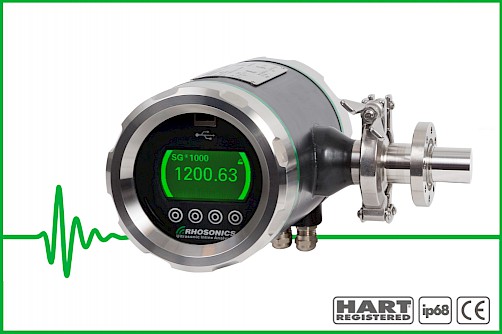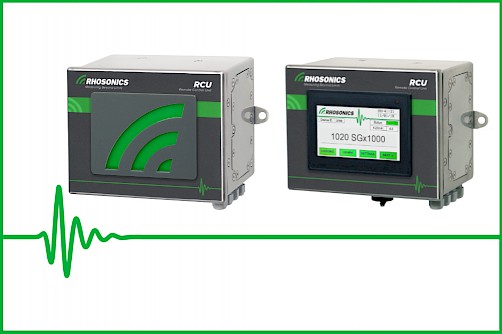Update Chrome Browser
SLURRY DENSITY METER - NON-NUCLEAR DENSITY MEASUREMENT
Non- Nucleonic Type Density Meters
Rhosonics helps mineral processing plants to replace nuclear density gauges by ultrasonic technology. This transition allows operators to achieve process optimization in a safer, more reliable, sustainable and cost effective way. This is how Rhosonics contributes to a greener and smarter industry.
Introduction
Dredging and mining companies are increasingly looking for non-nuclear measuring instruments, because of stricter government regulations, increasing safety related costs and the need to reduce nuclear waste. Rhosonics helps the industry to create a safe and pleasant work environment by offering non-nuclear (ultrasonic) technology for density measurement in slurries.
Our ultrasonic density meter eliminates all costs, health and safety risks related to the radiation source. The device is easy-to-use, has no need for any license and provides reliable density values to monitor and improve the production output.
With more than 800 installations worldwide and more than ten years of experience in the mining industry, Rhosonics has proven that ultrasonic sensors are suitable for the harshest process applications where typically only (radiation-based) technologies were applied.
Our solution
Rhosonics introduces the newest generation non-nuclear density meter, the SDM Slurry Density Meter. This instrument is suitable for real-time density measurement in all kinds of slurries. The product uses sustainable ultrasonic technology and is specifically designed for dredging and mineral processing applications after ten years of experience with the predecessor, the model 9690 density meter. The SDM uses a non-intrusive ultrasonic sensor to measure the real-time density of mineral slurries under high density levels and at very large pipes.
Technology
By measuring the acoustic impedance of a slurry, the SDM calculates the density of the slurry real-time during the process. The sensor is made of stainless steel and ceramic material. Because of the new sensor material, the sensor has lots of better properties. By making use of ceramics material, the ultrasonic signal is more brightful and powerful than before. Also, the sensor is more wear resistant than its predecessor, model 9690. Installation is easy and can be done by means of wafer cells, spool pieces or a weld-on piece (weldolet). The weldolet technology is a low-cost solution, especially for larger pipe sizes, since this method only requires a small hole in the existing pipe.
Mining Technology Excellence Award 2020
Rhosonics has won the ‘Environmental Impact’ category in the Mining Technology Excellence Awards 2020 from GlobalData. The award celebrates Rhosonics’ solution for non-nuclear density measurement, the SDM Slurry Density Meter, which is helping hundreds of processing plants around the globe to achieve a greener and smarter operation, as one of the greatest achievements and innovations in the mining industry.
The award is considered as a platform for the people and companies that are driving change. We are very proud of winning this award as recognition of our efforts to improve sustainability in the mining industry. In the last decades, we have become the global leader in non-nuclear density measurement for mining applications. Conventional nuclear density gauges are being replaced by the innovative and sustainable ultrasonic technology of Rhosonics to create a safer work environment.



Features and benefits
- Non-Nuclear density meter, ultrasonic technology
- Real-time density measurement
- Durable probe system
- Lowest possible maintenance needs
- High accuracy and reproducibility
- Suitable for all types of slurries
- Compact integrated system
- Process connection via HART and 4-20mA
- Continuous data & system logging
Manual sampling or real-time density measurement?
Mining companies have different ways to assess the efficiency of their classification processes. Some are doing it by manual sampling, others are using instrumentation combined with an advanced process control.
Manual assessment of the density can be done by Marcy Scales. This is a traditional method, which can be very time consuming and does not allow for a real-time process control. The density can be sampled and checked within five minutes, however this needs to be done three or four times per shift. Considering two or three shifts, this would take about 40 minutes a day and would require many people involved per shift. The reliability of the results is compromised as each individual sample and analyze the density differently.
When companies are applying on-line instrumentation, the number of manual samples will be reduced drastically. In this case, samples are only used to verify the density readings of the instrument. When adjustments are needed, this will generally take only a few minutes per density meter.
The use of online instrumentation allows for significant savings ($). Operators generally love the use of on-line instrumentation, because it improves the efficiency of the operation and saves time spent on manual sampling. The instrument helps to operate at a proper density level and can also prevent events like clogged pipes. Enough reasons to start with implementing further automation in the process.
Why non-nuclear density measurement?
Processing plants have been using radiation-based devices for decades. In the past, nuclear density gauges were the only available technology for real-time assessment of the process efficiency. To guarantee safe use of these nuclear instruments, governments are implementing regulations which are based on the guidelines of the International Atomic Energy Agency (IAEA). Globally, these regulations are becoming stricter and new rules are being introduced locally. For these reasons, a growing number of companies is seeking for sustainable alternatives such as the non-nuclear density meter of Rhosonics. This instrument helps them to get rid of the workload related to regulations, such as licenses, periodical inspections and transportation restrictions. At the same time, the ultrasonic technology of Rhosonics is not hazardous to the environment, which helps employees to feel safe at their work. The Rhosonics density meter has been verified against several nuclear gauges during field tests and delivers the same results for accurate and reliable assessment of the process efficiency.
If you want to learn more about the issues of working with nuclear gauges, then click on one of our blogs below. Or watch our free webinar recording about this topic.
Where can the density meter be used?
The Rhosonics density meter can be used in different applications and industries. In mineral processing, the instrument can be used for density control in the (re)grinding circuit, in the flotation circuit, in the tailings or in product thickeners and clarifiers among other slurry applications.
Better control of the grinding circuit
Water impacts the grinding process, therefore the efficiency of the ball mill can be greatly improved by better water dosage. This alone could improve the efficiency with 5-15% according to 911 mettalurgist. When this is combined with a control strategy, the improvement rate could be even higher. There are different points for measuring density in the grinding circuit. One of the applications is to monitor the dillution of material in the ball mill discharge, to improve the efficiency of the process. Another important application is to monitor changes of density in the cyclone underflow, this can be done to check the process stability and increases or decreases of circulating load.
Read more about grinding circuit optimisation in our blogs (1, 2, 3) and let us know if you want to receive our free whitepaper about five reasons to measure density in the grinding circuit.
Grinding circuit Blog 1/3: In-line measurement and process control
Grinding circuit Blog 2/3: Effective grinding and optimal classification
Grinding circuit Blog 3/3: Density to prevent problems with circulating load
Better control of the flotation circuit
Optimal flotation means reducing the amount of gangue that is sent together with valuable minerals to further stages of the process. An enriched product should be produced with the lowest energy costs, containing most valuable materials (the concentrate). Real-time density measurement can help to verify changes in the slurry from the grinding circuit to the flotation cells. The effect of flotation feed density on metallurgical performance has been investigated. Results of test work have shown that the pulp density affects key parameters of the flotation process in both the pulp and froth phases (Runge et al, 2012). One of the findings was that froth phase recovery presumably improves because of a stabilising effect due to a greater loading of solids on bubble surfaces. If you combine a density meter and a flow meter in the flotation feed and line of the final product of the flotation, this will allow a mass balance calculation and calculation of the efficiency of the circuit.
Read more about flotation circuit optimisation in our blogs (1, 2, 3 and 4) and let us know if you want to receive our free whitepaper about five reasons to measure density in the flotation circuit.
Flotation Circuit Blog 1/4: Purposes and benefits of measuring density in flotation
Flotation Circuit Blog 2/4: Effect of flotation feed density on metallurgical performances
Flotation Circuit Blog 3/4: The role of the flotation operator and instrumentation
Flotation Circuit Blog 4/4: How to prevent ore piling up in the flotation cells
Better control of the thickening process
In mineral processing operations, water is very important and therefore water recovery plants have an important position. According to CRC Care 2013, every year more than 10 billion tonnes of tailings are produced by mining activity. Thickeners can be used as a water recovery system, to meet requirements in the recovery and reprocess of water. A growth of 1 or 2% in underflow density can return large amounts of water to the operating installations. The increasing of density is also important to avoid accidents in tailings dams, which can collapse when there is too much liquid pumping to the dams. The thickening process can be monitored and improved by measuring density in the feed of the system, in the feedwell and in the underflow. Combined with a flow meter, the mass flow can be calculated, giving real-time insights about the effeciency of the thickener operation.
Read more about thickener optimisation in our blogs (1, 2 and 3) and let us know if you want to receive our free whitepaper about five reasons to measure density in the thickening process.
Thickener Blog 1/3: Improve water recovery
Thickener Blog 2/3: Improve metal recovery
Thickener Blog 3/3: Improve flocculant use
Other applications
Besides applications in the mineral processing industry, Rhosonics also has experiences in other industries. For example, in the dredging industry for measurement of density to control the operation and for calculation of the production efficiency and output. The density meter is also used by construction companies who are creating slurries which are used for new construction works, for example water locks, bridges and tunnels. Another application can be found in the energy industry, for the measurement of density in a limestone slurry. If you have a different application, then please contact us and check the general specification for process limitations. In most cases our slurry density meter will be suitable.
Performance specifications
| Method: | Ultrasonic Spectral Power /
Acoustic impedance |
| Density Range: | 700 … 3.000 g/l |
| Resolution: | 0.2 g/l |
| Readings: | S.G., Density g/l |
| Accuracy: | +/- 0.5% |
| Decay time: | 1 to 99 s (adjustable) |
| Display: | Monochrome display with RGB backlight, visible through glass cover. |
| Operation: | Push-buttons, HART, Computer
Optional: RCU Remote Control Unit |
General specifications
Process conditions |
|
| Pressure: | 1 … 16 bar |
| Temperature: | 0 °C … 110 °C (32 °F … 230 °F) |
| Wetted materials: | Ceramics and Duplex Stainless steel 1.4462 |
Electrical specifications |
|
| Power supply: | 18 … 32 VDC, 8 Watt
Optional: Power supply/converter for 90 … 240 VAC |
| Output: | 4 … 20 mA / HART |
| Communication: | 2-way through HART protocol
Optional: RCU unit as converter to Modbus RTU or Profibus DP |
| Data logging & fault reporting: | Internal memory,
via USB memory stick |
| Cable entries: | 3X M16X1.5, cable OD Ø 3-10 mm |
Ambient conditions |
|
| Ambient temperature: | -20 °C … +65 °C (-4 °F … 149 °F) |
| Humidity: | < 95% at 40 °C (noncondensing) |
| Protection: | IP68, NEMA 6P
|
| Vibration: | Resistant to moderate / high vibration of pumps |
Dimensions and weights |
|
| Weight: | Approx. 6.4 – 6.8 kg |
| Housing materials: | Coated stainless steel |
| Housing dimensions: | 348 (L) x 208 (W) x 170 mm (H) |
| Process connection: | UFTP Spool
Weldolet Wafer |
| Standards: | DIN/ANSI/JIS (others on request) |
| Nominal pipe size: | Up to 60” |
Digital communication via HART
The SDM is a HART certified device. It can communicate digitally with other HART equipment using the analogue 4-20 mA output.
The HART protocol enables remote access and control e.g:
Calibration
Variable readout
Variable ranging
Etc.
RCU Remote Control Unit / Communication Protocol Converter
The newest Rhosonics instruments, such as the SDM, are supplied with sensor, display and operation panel integrated in a compact all-in-one system. The user interfaces of these instruments can sometimes be hard to reach, for example because of installation in a difficult position of the process pipe. Yet, in these cases, the Rhosonics RCU Remote Control Unit will be the perfect solution.
This multifunctional device is connected to the instrument by cable and can be used to monitor measurement results and change settings real-time at a safe and convenient location near the process. Another feature of the RCU is the communication protocol converter. For example, one of the RCU models is equipped with a HART/4…20 mA signal to Modbus RTU signal converter which can be very useful in case a Modbus RTU output is required. The HART/4…20 mA signal can also be converted to a digital Profibus DP signal. Click here to learn more about the RCU models.


SDM WT
Rhosonics introduces the Slurry Density Meter WT (SDM WT). This robust ultrasonic measuring instrument shows the density value in wt% solids with an accuracy up to 0.005 wt%. The SDM WT can measure the density of challenging water-based slurries in industries like dredging and mineral processing. For many years, nuclear devices were the only option. Nowadays the non-nuclear SDM WT is used to replace these radiation sources. Rhosonics employs the field proven ultrasonic technology for density measurement. The Rhosonics Slurry Density Meter has its sensor, analyzer, cable and software integrated in just one system. The density meter is compact and lightweight. With the SDM WT, we can offer the second generation non-nuclear density meter to customers who were demanding wt% solids as measurement value.
Performance specifications:
| Method: | Ultrasonic Spectral Power /
Acoustic impedance |
| Density Range: | 0…80 wt% |
| Resolution: | 0.02 wt% |
| Readings: | Density in wt% solids |
| Accuracy: | +/- 0.1% of reading |
| Decay time: | 1 to 99 s (adjustable) |
| Display: | Monochrome display with RGB backlight, visible through glass cover. |
| Operation: | Push-buttons, HART, Computer
Optional: RCU Remote Control Unit |
The general specifications of the SDM WT are the same as the SDM (see above).



